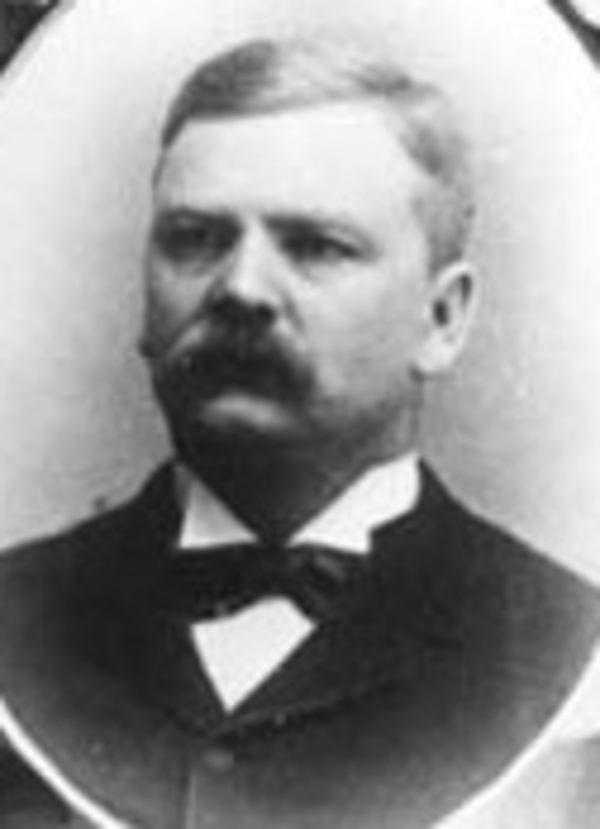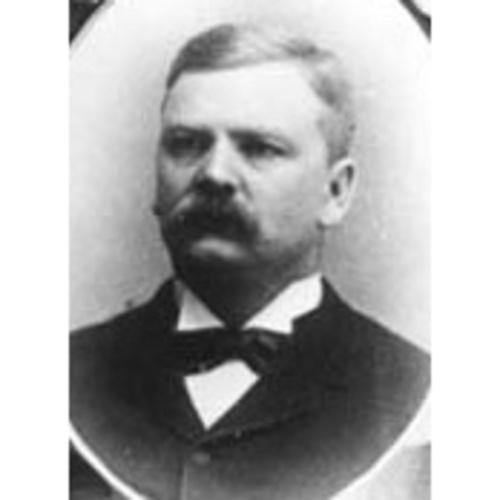
Source: Courtesy of Wikimedia Commons
TWEED, THOMAS ANDREW, businessman and politician; b. 14 April 1853 in Kingston, Upper Canada, son of Thomas Tweed, a sawyer, and Jane Hiditch; m. 3 June 1873 Helen Sutherland of Kingston, and they had two sons and a daughter; d. 4 April 1906 in Montreal.
Thomas Tweed received his education in Kingston and then entered an apprenticeship in a retail drygoods firm in the town. At 17 years of age, he joined the expeditionary force under Colonel Garnet Joseph Wolseley* that was sent to pacify Manitoba in 1870 [see Louis Riel*]. Subsequently Tweed worked in the cotton industry, for a short time in Montreal and then in Cornwall, Ont., where in his late twenties he took up the managership of the Stormont Cotton Manufacturing Company Limited [see Andrew Frederick Gault]. Lured, however, by the prospects offered by the construction of the Canadian Pacific Railway, he gave up his promising business career and headed west. He arrived at Medicine Hat coulee (Alta), where the railway was to cross the South Saskatchewan River, in May 1883, just before the steel was laid.
Tweed and his partner, James Alexander Lougheed*, established a general store in a tent. A village sprang up, and Tweed quickly became one of Medicine Hat’s wealthiest citizens. After Lougheed moved on to Calgary, Tweed joined with another young easterner, John Ewart, in setting up a second retail outlet, at Lethbridge, in November 1885. They also established one of the first large-scale ranching operations in the district, the Medicine Hat Ranche Company, in 1899.
When an elected legislature was created for the North-West Territories in 1888, Tweed contested the seat of Medicine Hat in the election that year. A professed and active Conservative, he won against William Thomas Finlay*, also of Medicine Hat, after an acrimonious campaign. In Regina, the territorial capital, his talents were soon recognized. He joined with the members led by Frederick William Gordon Haultain* who were struggling against the federally appointed lieutenant governor, Joseph Royal, to obtain responsible government for the territories. A member of the executive and chairman of the education committee, he was an outspoken advocate of English-only language provisions for territorial schools in this period when legal changes were leading to an erosion of minority educational rights.
The high point of Tweed’s political involvement came in 1891. Early that year he contested the Conservative nomination for Assiniboia West, the large federal riding that included Medicine Hat. In doing so he challenged the sitting member, Nicholas Flood Davin, who won handily. Tweed then decided to run as an independent in the March election. He and his supporters maintained that Davin’s drinking problems nullified his effectiveness in the House of Commons, but Davin was a well-liked politician backed by a powerful local machine, and he won in a landslide. Tweed’s unpopular stand alienated many prominent citizens in his own community, and it also lost for him his postmastership, which he had held since 1883. He was, however, returned by acclamation to the territorial assembly in November 1891.
Between 1891 and 1894 tiny Medicine Hat became embroiled in conflict, much of which swirled around Tweed himself and which drove a wedge through the local élite. Even though he assisted in shaping a new liquor-licensing system after he was returned to Regina in 1891, many of his associates were prominent leaders in temperance societies and anti-prohibitionists suspected him of sympathizing with the rigid prohibitionary legislation that had been imposed on the territories in 1873 by the federal government. As well, he was accused of attempting to influence purchasing by the local hospital and school boards and of obtaining contracts for his friends. These acrimonious controversies postponed incorporation at a crucial time in the community’s economic development.
In November 1894 assembly elections again took place. Tweed’s enemies had found a popular rancher from Maple Creek (Sask.), Edward Fearon, to oppose him. Tweed was depicted as hostile to labour, inimical to the establishment of responsible government in the territories, and oblivious to the constituency’s best interests. Fearon was elected, and so deeply was Medicine Hat divided that another four years would pass before incorporation could again be seriously addressed. By that time Calgary had been enjoying the psychological and economic advantages of municipal status for 14 years.
In the meantime Tweed returned to his business and ranching interests, finding pleasure in community involvement and his growing family. Typical of the prairie entrepreneurial élite of the day, he had always invested personal energy in his chosen home. He was instrumental in establishing St John’s Presbyterian Church in 1883, the local board of trade in 1887, and the hospital in 1889. As well, he was active in the masonic order and several other fraternal organizations. During the 1885 rebellion, when Medicine Hat feared roving bands of hungry Cree, he had organized local defences. In 1886 he was appointed a justice of the peace, and in the late 1890s he helped establish a hockey club and a dramatic society. After his retirement from mercantile affairs in 1902 he had time to assist in the promotion of irrigation schemes for the dry lands of the district. He was on the executive of the Western Stock Growers’ Association and the Territorial Boards of Trade. In 1903 he was chairman of the Conservative convention at Moose Jaw (Sask.).
Tweed died of heart failure in Montreal, after a holiday abroad. An attractive man with a commanding presence, he had demonstrated leadership in his own community and throughout the North-West Territories. He was the prototype of the Ontario-born entrepreneurs who seized control of the prairie west in the late 19th century and imposed on it the image of their birthplace.
Medicine Hat Museum and Art Gallery, Arch. (Medicine Hat, Alta), M.84.1.38 (Hist. Soc. coll., biog. sect.), esp.B.6, F.7; photographs of T. A. Tweed. Medicine Hat News, 30 Aug., 3 Nov. 1894; 26 Dec. 1895; 20 Nov. 1898; 9 March, 13 July 1899; 5 April 1906. Medicine Hat Times, 5 Jan. 1886, 3 April 1887, 21 June 1888, 8 June 1889, 4 March 1891. Regina Standard, 11 April 1906. R. Common, “Early settlement about Medicine Hat, Alberta,” Geographical Bull. (Ottawa), 9 (1967): 284–93. F. W. Gershaw, Sammis, the Medicine Hat (Medicine Hat, 1967). J. W. Morrow, Early history of the Medicine Hat country ([Medicine Hat], 1923; repr. 1964). L. J. R. Wilson, “‘Everlasting squabble’: Medicine Hat in crisis, 1891–98,” Alberta Hist. (Calgary), 35 (1987), no.1: 1–12.
Cite This Article
L. J. Roy Wilson, “TWEED, THOMAS ANDREW,” in Dictionary of Canadian Biography, vol. 13, University of Toronto/Université Laval, 2003–, accessed January 8, 2026, https://www.biographi.ca/en/bio/tweed_thomas_andrew_13E.html.
The citation above shows the format for footnotes and endnotes according to the Chicago manual of style (16th edition). Information to be used in other citation formats:
| Permalink: | https://www.biographi.ca/en/bio/tweed_thomas_andrew_13E.html |
| Author of Article: | L. J. Roy Wilson |
| Title of Article: | TWEED, THOMAS ANDREW |
| Publication Name: | Dictionary of Canadian Biography, vol. 13 |
| Publisher: | University of Toronto/Université Laval |
| Year of publication: | 1994 |
| Year of revision: | 1994 |
| Access Date: | January 8, 2026 |



